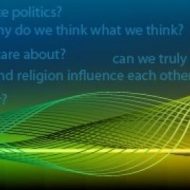 By Connor Wood
By Connor Wood
If you watch the news or read the opinion pages, you could be forgiven for thinking that liberals and conservatives are members of completely different species. But why is it that these different groups have such a hard time getting along? A team of scientists from Nebraska thinks that the answer has to do with people’s bodies – specifically, how they’re physiologically predisposed to respond to the good and bad in their environments. The difference between conservatives and liberals, then, may go all the way down to the brainstem, and this difference can affect religious ideology too.
Conservative thinkers often deride liberals for being hedonistic, so obsessed with pleasure that they neglect the difficult and demanding aspects of life. To back up their point, these conservative commentators draw on images of free-love communes, LSD experimentation, and increasingly permissive social norms. Liberals, they claim, are often too interested in cheap thrills to take life seriously.
Meanwhile, liberals accuse conservatives of being fearful, close-minded, and distrustful of outsiders. They point to conservatives’ approval of high defense spending, severe punishments for criminal offenders, and harsh policies against illegal immigrants as evidence. In liberals’ eyes, their poor, uptight conservative brethren are constantly in vigilance mode, always seeing threats, never able to simply relax and take life as it is.
Unfortunately, reality sometimes matches our caricatures of it – and it seems as if both these stereotypes may offer up some grains of truth. Led by psychologist Michael D. Dodd, researchers at the University of Nebraska, Lincoln, recently tested conservative and liberal volunteers to see what kinds of stimuli most affected them, and found that liberals were more physiologically stimulated by pleasant images, while conservatives reacted more strongly to negative ones.
Dodd and colleagues had 200 participants from the Lincoln area take four different tests of political orientation, agglomerating that data to produce an overall measure of political ideology, with pure conservatives at one pole and pure liberals at the other. Then, the researchers asked a team of third-party judges to rate a series of more than thirty pictures, ranking them according to how positive or negative the images seemed to be. The three most negative images were of a spider on a man’s face, an infected, maggot-ridden wound, and a solitary man fighting an entire crowd of people. The three most positive images, on the other hand, were a picture of a happy child, a photo of a bowl of fruit, and an image of a cute bunny rabbit.
All 33 images were shown to the volunteers. As they viewed the pictures, electrodermal measurement instruments took readings of the volunteers’ skin conductance levels. (Electrodermal measurement serves as a nice proxy for physiological arousal. The more easily electricity can travel across your skin at any given time, the more your eccrine glands are producing moisture that coats the skin’s surface. Eccrine gland activity, in turn, is an indicator of general sympathetic nervous system arousal. In other words, if your skin conducts electricity well, you’re probably excited, whether pleasantly or not.)
When the researchers correlated the skin-conductance tests against records of the different images the volunteers had viewed, they found precisely what they had been expecting: participants who had tested as highly conservative were much more physiologically aroused by the most negative images, while highly liberal volunteers showed the most increase in skin conductance levels when they saw happy images of children or cute animals.
What’s more, the relationship was ordinal: the more liberal a participant was, the more strongly he or she could be expect to react to positive stimuli. And the more conservative someone was, the more strongly his or her body reacted, on average, to the negative images.
A second test measured skin conductance levels against different kinds of images: pictures of the well-known political figures Bill Clinton, Hillary Clinton, Ronald Reagan, and George W. Bush. As expected, the liberals showed the greatest electrodermal response to images of politicians they probably agreed with – namely, the Clintons. But conservatives were the opposite. Their bodies reacted most strongly to the politicians they disagreed with – again, those darn Clintons.
In a final study, the researchers used a different measure of physiological attention. Participants were shown a collage of different images, some pleasant, some unpleasant. Computerized eyetracking instruments determined where on the screen participants were focusing their visual attention, how quickly they were selecting which images to focus on, and how long their attention remained on each image.
Again, the model held: liberals spent more time looking at pleasant images, while conservatives gazed longer at the disgusting or frightening ones. Liberals found the nice images more quickly, while the conservatives honed in on the unpleasant pictures with alacrity.
Overall, conservatives seemed to be more primed to pay attention to and physiologically respond to dangerous, unpleasant, or threatening images, while liberals’ bodies were most reactive to pleasant or happy pictures. The authors of the study pointed out that this dichotomy intuitively makes sense: in the U.S., liberals are more interested in spending public money on pleasant, enjoyable programs, like the National Park Service or arts endowments. Meanwhile, conservatives tend to support spending on defense, prisons, police forces, and anti-immigration policies.
In the religious arena – which the authors of the study didn’t address directly – the model also jibes with reality. Religious conservatives are notable for their dim view of human nature, while religious liberals tend to see humans as divinely good. Conservative Christians emphasize original sin, while liberal Protestants focus on humankind’s inherent beauty and potential for growth.
While many might be tempted to read this research as proof that conservatives are somehow defective compared to fun-loving, pleasure-seeking liberals, such a conclusion would be premature. First, the evidence is clear that conservatives aregenerally happier and often have better family lives than liberals. Second, the world is, in fact, not all daisies and roses; danger and threat are, to paraphrase William James, genuine portions of reality. Physiologically, then, conservatives may be more well-adapted to deal with the world as it actually is. Indeed, conservatives often accuse liberals of being unrealistic and naïve, and in many cases there may be something to this accusation. Meanwhile, religiously speaking, a faith system that doesn’t shy away from facing the the dark aspects of the world may have a psychological edge over one that focuses predominately on goodness and happiness to the exclusion of dealing with pain, suffering, and evil.
But the most productive way to read this research is probably that liberals and conservatives both have valid ways of responding to their environments, and societies may benefit greatly from having both types in their midst.
A culture dominated by conservatives, for example, could be quite a grim thing indeed – think security cameras everywhere, police on every corner, and endless military buildup. A purely liberal culture, on the other hand, would be like your average dysfunctional hippie farm – everyone wants to have fun and get stoned, but no one wants to actually do the work of growing crops or taking out the trash, because those things aren’t fun. Let’s be honest: neither one of these worlds sounds very desirable.
The fact is that reality is chock-full of both wonderful and horrifying things, and if some people are preprogrammed to pay more attention to one than the other, then so be it. As long as we’ve got all types in our midst, we can always rely on somebody to point out the good, the bad, and the ugly. Or, as the case might be, the bunny rabbits, bar fights, and spiders.
